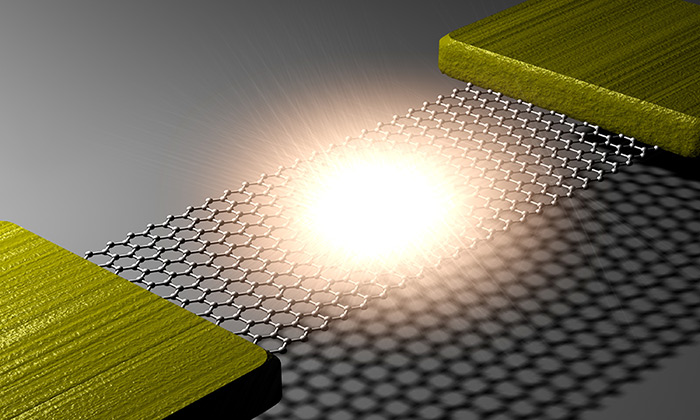
A team of scientists and engineers from Columbia University, Seoul National University (SNU), Korea Research Institute of Standards and Science (KRISS) and The University of Texas at Austin have demonstrated — for the first time — a visible light source using graphene, an atomically thin form of carbon. This new type of light source could form the basis of faster communications devices and computer displays that are thin, flexible and transparent.
The work is published online in Nature Nanotechnology June 15.
This video shows how the new graphene-based light source works. Credit: Myung Ho Bae/KRISS.
The researchers attached small strips of graphene to metal electrodes, suspended the strips above a silicon chip and passed a current through the filaments to cause them to heat up.
"We’ve created what is essentially the world’s thinnest light bulb," says James Hone, a professor of mechanical engineering at Columbia University and co-author of the study.
The team used a special form of the same material that Thomas Edison used when he invented the incandescent light bulb. Edison used carbon as a filament for his light bulb. The new light source uses the same element in its pure form — graphene — and at its ultimate size limit — one atom thick.
Yujin Cho, a doctoral student in physics at The University of Texas at Austin who worked on the project as a student in South Korea, measured the light output of the tiny devices while applying a range of voltages.
"It was exciting to be able to see such bright, visible light from this device with my own eyes," says Cho.
Creating light in small structures on the surface of a chip is crucial for developing fully integrated photonic circuits that do with light what is now done with electric currents in semiconductor integrated circuits. Researchers have developed many approaches to do this but have not yet been able to put the oldest and simplest artificial light source — the incandescent light bulb — onto a chip. This is primarily because light bulb filaments must be extremely hot — thousands of degrees Celsius — in order to glow in the visible range, and micro-scale metal wires cannot withstand such temperatures. In addition, heat transfer from the hot filament to its surroundings is extremely efficient at the micro-scale, leading to damage of the surrounding chip.
By measuring the spectrum of the light emitted from the graphene, the team was able to show that it was reaching temperatures above 2,500 degrees Celsius, hot enough to glow brightly.
The ability of graphene to achieve such high temperatures without melting the substrate or the metal electrodes is due to another interesting property: As it heats up, graphene becomes a much poorer conductor of heat. This means that the high temperatures stay confined to a small "hot spot" in the center. This increases the energy efficiency of the new light source 1,000 times, as compared with graphene on a solid silicon chip.
The team also demonstrated the scalability of their technique by constructing large-scale arrays of chemical-vapor-deposited graphene light emitters.
The group is currently working to further characterize the performance of these devices — for example, how fast they can be turned on and off to create bits for optical communications — and to develop techniques for integrating them into flexible substrates.
In addition to Yujin Cho, the study's co-lead authors are Young Duck Kim at SNU and Columbia University; Hakseong Kim at Konkuk University (Republic of Korea); and Ji Hoon Ryoo at SNU. The research was conceived by Young Duck Kim; Myung-Ho Bae at KRISS and the University of Science and Technology (Republic of Korea); and Yun Daniel Park at SNU.
Read the paper, "Bright visible light emission in graphene" (Nature, June 15, 2015): http://dx.doi.org/10.1038/nnano.2015.118
This press release was adapted from a release produced by Columbia University.

















Comments